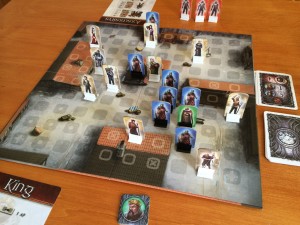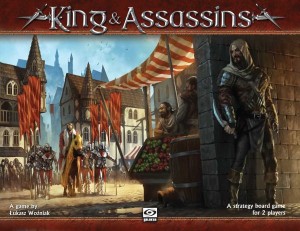Review: King and Assassins
Posted by James (admin) on July 16th, 2014
 King and Assassins is an asymmetric, 2-player game where the King player controls the king and his knights; whereas, the Assassin player controls the villagers in the town of which 3 are assassins who are trying to kill the king.
King and Assassins is an asymmetric, 2-player game where the King player controls the king and his knights; whereas, the Assassin player controls the villagers in the town of which 3 are assassins who are trying to kill the king.
The rules are simple. Each player has a number of action points (APs) to spend on their turn which can be used to move their figures, make attacks, etc. Each turn, a card is drawn which determines how many APs the King player can spend (there are separate amounts for the king and to be spent amongst the knights), plus it shows if a knight can arrest 1 villager that turn (permanently removing it). Also, each card shows how many APs the Assassin player can spend on their villagers/assassins too. If the cards run out or the king is killed (wounded twice) before reaching the castle, the Assassin player wins.
The Assassin player starts with lots of villagers and only they know which 3 are actually assassins (as these are determined at the start of the game). Villagers can not attack, but the Assassin player can reveal any of the villagers that are assassins at any time so they can attack the king and knights, plus assassins are faster up and down buildings too.
The many knights accompanying the king can be positioned to shield him from the potential threat of villagers and the knights are stronger than the villagers so they can push them out of the way. However, whilst the knights and villagers can move over the town’s rooftops (although it takes extra APs to do so), the king must remain on the ground which creates potentially dangerous (but unavoidable) bottlenecks when passing between the buildings as every villager is a potential assassin.

Overall, King and Assassins is a fast-moving, short game with lots of quick decisions as well as some tension. The action point game mechanic works well – it’s very simplistic, as there is no maximum on how many can be spent on one figure, but this is fine in a simple game.
Both players have different perspectives of the board which is something I always like in a game – the King player doesn’t know which villagers are the assassins, and the Assassin player doesn’t know which villagers the King player suspects of being assassins or which route the king will take.
Both players have to balance how they use their APs. The king and knights must move slowly and carefully enough to keep the king protected, but quickly enough to reach the castle in time, avoid attacks and move to arrest villagers. At the same time, the Assassin player must balance moving lots of villagers a little compared to moving a few villagers a lot, and balance moving assassins and non-assassins. This is where the mind games start to be played. Is the Assassin player moving one villager a lot because they are an assassin moving into position, or is that just what they want the King player to think whilst they subtly move the real assassins? Where along the route will the assassins strike? Has the Assassin player grouped their assassins together or are they spread out? Are all 3 assassins still remaining or were some of them amongst the villagers that have been arrested (removed) already?
I like that there are no dice rolls for combat – one wound kills a knight or assassin (two wounds kill the king) which makes it a simple, as well as fairly brutal, game. However, the removal of figures is limited because villagers (or assassins who are still disguised as villagers) can’t attack, and the King player can only arrest 1 villager per turn and that’s only if the turn’s card says they can.
Whilst combat does not involve luck, luck can still play a part in the game for two reasons. First, the order the cards appear in can make a big difference – if lots of cards that allow arrests, and/or cards that allow the king to move more quickly, appear early in the game then the game is much harder for the Assassin player – conversely, the game can be much harder for the King player if they get few APs and no arrests from the first cards. Second, the King player can simply get lucky and accidentally arrest some of the unrevealed assassins early on (before they get to do any assassin actions) without having really had any information to base the arrest on. I don’t mind this luck factor too much as it’s such a short and simple game, but it can be frustrating (and very difficult) for the Assassin player if assassins get removed without doing anything through no real fault of their own. I did wonder if the king should need to spend one of his APs to order the arrest of a villager so there was a penalty for arresting someone to balance.
The board is double-sided with two different building layouts. This adds some longevity/variety to the game but I would have liked to have seen more. The board could have been more plain but with elements (tiles) like buildings, market stalls, wells, etc. to place on the board so the layouts could be much more varied, with some official layouts in the rules and players could also design their own layouts too. Alternatively, the board could have been comprised of 4 double-sided sections, instead of 1 large, foldable piece, and these sections could then be combined in lots of different ways to make different layouts – not only using different sides and rotations, but also laying them out in different shapes too, such as a long corridor, not just 2 x 2. Plus, the castle (goal) could have been a location on a separate tile (just an exit marker) so it could be off-board leaving more room for movement and layout.
I really like King and Assassins. It’s short and quick so it feels more like a decent filler for two rather than a larger game. Without the extra variety, it feels like it’s the ‘basic’ game and there could have been more rules for extra variety to deliver the ‘advanced’ game. Different assassin and knight types could be created by having different actions costing different amounts of APs, or some special actions could be only used once per game, or instead of the player’s entire turn. There could even be different kings who each have a different ability (which could also be limited) such as all villagers back away by 1 space, or the king gives a nearby villager an order (which allows the King player to move the villager unless the Assassin player immediately reveals them to be an assassin). Different kings could be mixed with different types of guards, and so on. Nothing too detailed as this isn’t meant to be a detailed miniatures game, just some simple rules to add tactical variety and add more longevity. (With different kings and board set-ups, players could play a series of games where several kings must each reach the castle and the Assassin player could choose in which of the games where their various assassins would appear.)
Overall, King and Assassins is a light and quick game with simple rules and potential for misdirection and bluffing. The mind games between the players is definitely one of the elements that adds a lot to the enjoyment. Whilst there is a potential for some luck in the card draw, it usually balances out so the game delivers a fun and tense feel with a quick play time. I would have liked a bit more content included but, as it is, it’s an enjoyable, short, light and tactical game for 2-players.
James.
[Played with 2 players]

